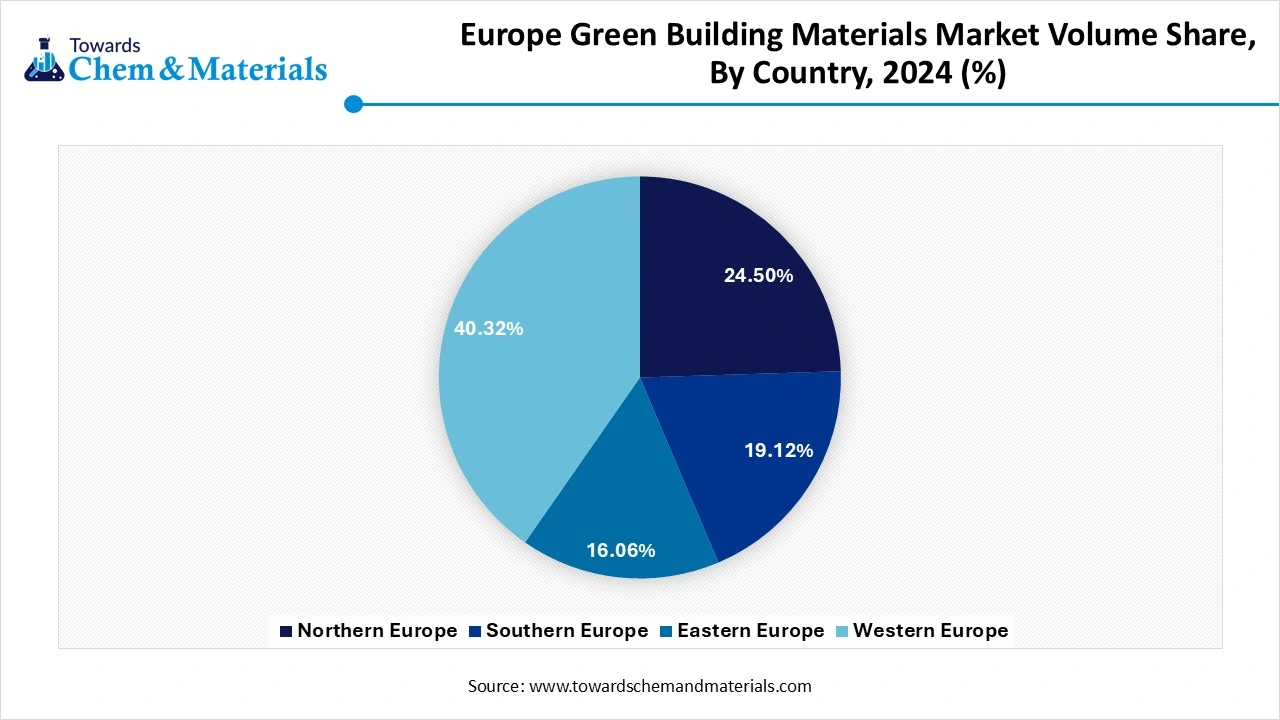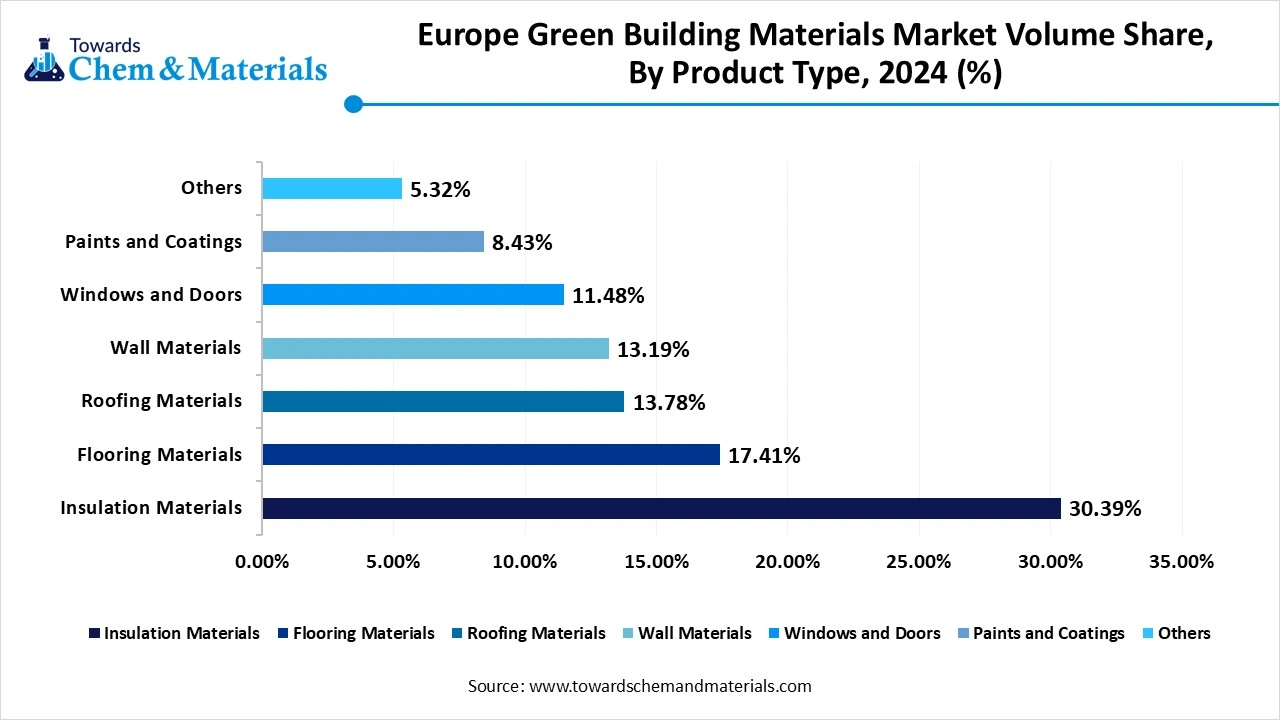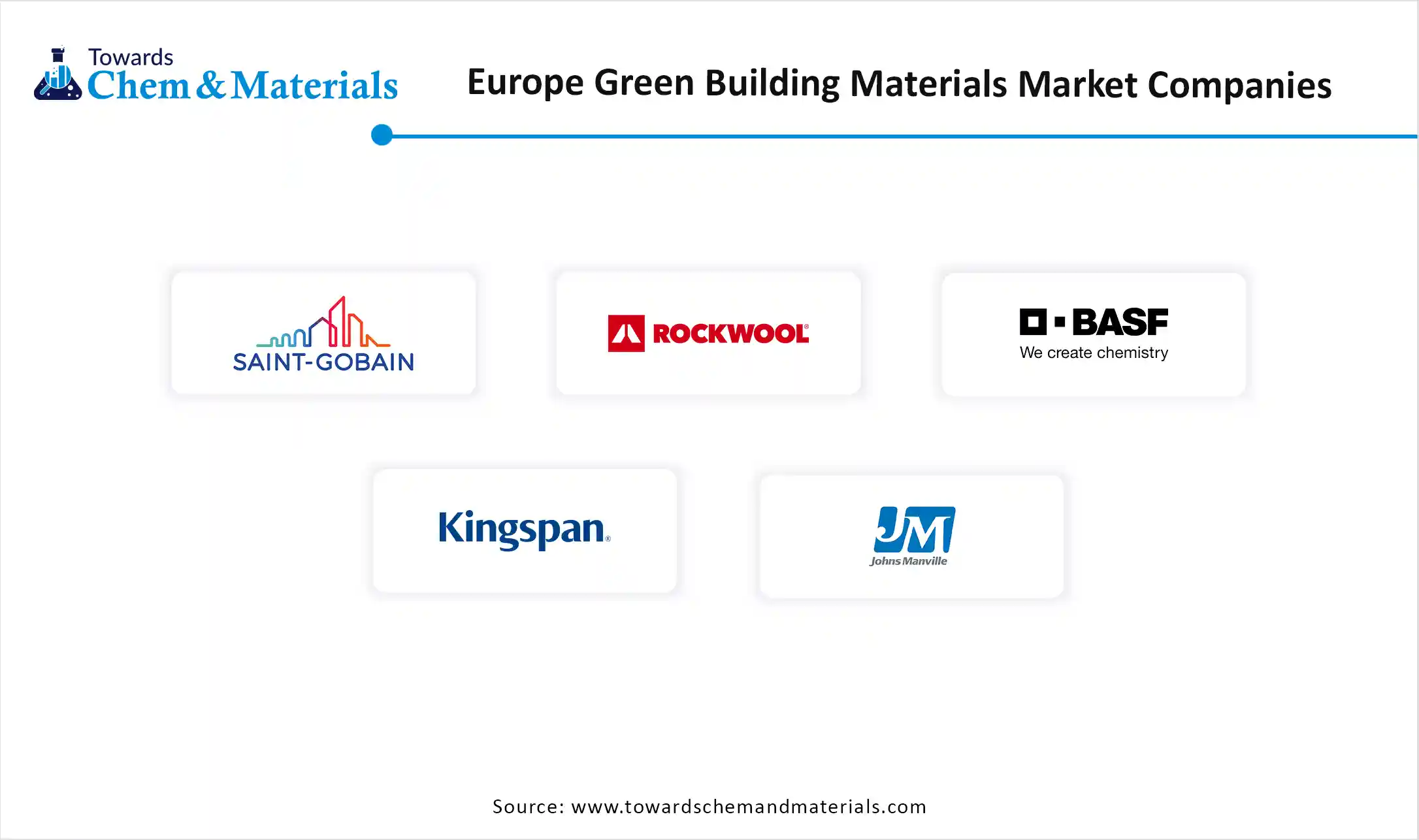December 2025
The Europe green building materials market volume was reached at 169.9 million tons in 2024 and is expected to be worth around 406.7 million tons by 2034, growing at a compound annual growth rate (CAGR) of 9.12% over the forecast period 2025 to 2034. The surge in environmental awareness is the key factor driving market growth. Also, a rise in government incentives coupled with innovations in building technologies can fuel market growth further.

The European green building materials market refers to the market for materials used in the construction and renovation of buildings that are designed to minimize their environmental impact. These materials are energy-efficient, sustainable, and environmentally friendly. They focus on reducing waste, enhancing energy efficiency, and improving indoor air quality.
The market includes materials used in insulation, flooring, roofing, paints, windows, and other building components, with a growing emphasis on eco-friendly alternatives, energy savings, and sustainable sourcing. Major players in the market are increasingly focusing on advancements, acquisitions, and strategic collaborations to expand their market presence in the region.
Governments in the region are actively promoting the market through a combination of financial incentives, regulations, and public procurement policies. These efforts are minimizing carbon emissions by improving energy efficiency and supporting sustainable construction practices. Moreover, schemes such as LEED and BREEAM optimise the utilisation of sustainable materials in construction techniques, impacting positive market growth soon.
| Report Attribute | Details |
| Market Volume in 2025 | 185.4 Million Tons |
| Expected Volume by 2034 | 406.7 Miliion Tons |
| Growth Rate from 2025 to 2034 | CAGR 9.12% |
| Base Year of Estimation | 2024 |
| Forecast Period | 2025 - 2034 |
| Segment Covered | By Material Type, By End-Use Application, By Technology, By Region |
| Key Companies Profiled | Saint-Gobain, Rockwool International, BASF SE, Kingspan Group, Johns Manville (a Berkshire Hathaway company), Owens Corning, CSR Limited, Knauf Insulation, Sika AG, Mineral Resources Limited, Etex Group, Interface, Inc., 3M, Boral Limited, Dow Inc., Green Building Council (GBC), Solvay SA, Titan Cement International S.A., USG Corporation, Kingspan Insulated Panels |
Green building materials have experienced a substantial development in recent years, with an emphasis on eco-friendly and sustainable alternatives for insulation, creating lucrative opportunities in the market. Furthermore, mycelium composites, a latest class of green building materials, are increasingly gaining traction. Made from mycelium, these composites provide exceptional insulation properties and are easily biodegradable.
Green building projects necessitate skilled labor with high expertise in BIM, energy-efficient design, and sustainable construction methods, which leads to higher labor costs, hampering market growth. Moreover, deploying renewable energy systems like geothermal and smart technologies, such as HVAC, adds further to the upfront investment, which again increases the overall implementation costs.
The Western Europe region dominated the market with a 50% market share in 2024. The dominance of the region can be attributed to the ongoing implementation of various government initiatives, which focus on smart renovations utilising green building materials to improve the sustainability of Europe's housing sector. In addition, innovations in ventilation, smart heating, and air conditioning (HVAC) systems are propelling energy usage in green buildings.

Europe Green Building Materials Market Volume Share, By Region, 2024-2034 (%)
| By Region | Volume Share, 2024 (%) | Market Volume Million Tons - 2024 | Volume Share, 2034 (%) | Market Volume Million Tons - 2034 | CAGR (2025 - 2034) |
| Northern Europe | 24.50% | 41.6 | 23.12% | 94.0 | 9.47% |
| Southern Europe | 19.12% | 32.5 | 20.10% | 81.7 | 10.80% |
| Eastern Europe | 16.06% | 27.3 | 17.67% | 71.9 | 11.36% |
| Western Europe | 40.32% | 68.5 | 39.11% | 159.1 | 9.81% |
| Total | 100.00% | 169.9 | 100.00% | 406.7 | 9.12% |
The Northern Europe region is expected to grow at the fastest CAGR over the forecast period. The growth of the region can be credited to the strict regulations supporting energy-efficient buildings, raised environmental awareness, and innovations in material science. Furthermore, northern European regions are especially emphasizing enhancing energy efficiency in buildings, which directly impacts the positive regional growth.
Who is the Top 5 Biggest Construction Companies in Europe?
| Company | Revenue 2024 (First nine months) (EUR Million) |
| Bouygues SA | 41,500 |
| ACS SA | 29,702 |
| VINCI SA | 23,545 |
| Eiffage SA | 14,834 |
| Strabag SE | 13,618 |
Which Material Type Segment Dominated the Europe Green Building Materials Market in 2024?
The insulation materials segment held a 40% market share in 2024. The dominance of the segment can be attributed to the increasing concerns associated with shifting climatic conditions, along with the growing need for energy-efficient insulation materials. Additionally, green insulation possesses superior properties to conventional insulation materials to emphasize minimizing carbon emissions and energy consumption.

The green concrete segment expects the fastest growth over the forecast period. The growth of the segment is due to the ongoing advancements in concrete production, such as the use of substitute raw materials with improved performance characteristics, which are enabling green concrete to become more appealing. Both commercial and residential sectors are witnessing growing adoption of green concrete due to its performance benefits.
Europe Green Building Materials Volume Share, By Material Type, 2024-2034 (%)
| By Product Type | Volume Share, 2024 (%) | Market Volume Tons - 2024 | Volume Share, 2034 (%) | Market Volume Tons - 2034 | CAGR (2025 - 2034) |
| Insulation Materials | 30.39% | 51.6 | 29.58% | 120.3 | 9.85% |
| Flooring Materials | 17.41% | 29.6 | 16.41% | 66.7 | 9.46% |
| Roofing Materials | 13.78% | 23.4 | 14.30% | 58.2 | 10.64% |
| Wall Materials | 13.19% | 22.4 | 15.12% | 61.5 | 11.87% |
| Windows and Doors | 11.48% | 19.5 | 9.50% | 38.6 | 7.89% |
| Paints and Coatings | 8.43% | 14.3 | 9.22% | 37.5 | 11.28% |
| Others | 5.32% | 9.0 | 5.87% | 23.9 | 11.39% |
| Total | 100% | 169.9 | 100% | 406.7 | 9.12% |
Why the Residential Segment Held a Largest Europe Green Building Materials Market Share in 2024?
The residential segment led the market by holding 45% market share in 2024. The dominance of the segment can be linked to the changing consumer inclination towards healthier living spaces, coupled with the innovations in material science. Moreover, many European governments are offering subsidies and incentives for green building projects, further driving the adoption of green building practices in the residential sector, fuelling market growth shortly.
The commercial segment is expected to grow at the fastest CAGR over the projected period. The growth of the segment can be driven by increasing focus on minimizing carbon footprints to improve the sustainability of commercial structures. Also, the surge in research and development in green building technologies in emerging economies is boosting the adoption of sustainable materials in the commercial sector.
How Did the Energy-Efficient Technologies Segment Dominated the Europe Green Building Materials Market in 2024?
The energy-efficient technologies segment dominated the market with 35% market share in 2024 and is expected to sustain its dominance over the forecast period. The dominance of the segment is owed to the growing demand for cost-effective and sustainable building solutions along with the rapid advancements in green building materials, like energy-efficient windows and advanced insulation, which are enabling green building to become more affordable and accessible in the region, leading to segment expansion soon in the market.
The recyclability & sustainability segment is expected to grow at a notable CAGR during the projected period. The growth of the segment is due to the rising focus on the circular economy in construction, emphasizing recycling, reuse, and reducing waste. Furthermore, governments across the region are increasingly implementing regulations and policies to facilitate sustainable construction across Europe.

By Material Type
By End-Use Application
By Technology
By Region
December 2025
December 2025
December 2025
December 2025